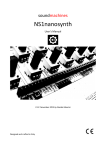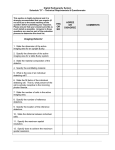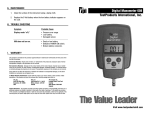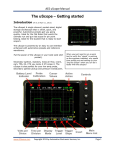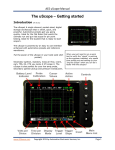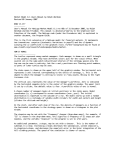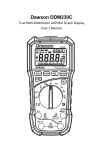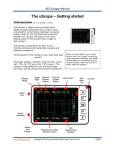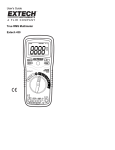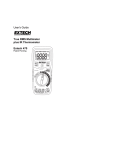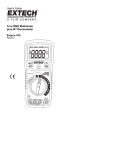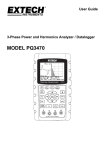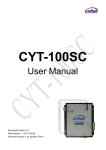Download TPI 296 Digital Clamp-On Multi
Transcript
296 Digital Clamp-on Meter Amp Plus Instruction Manual TABLE OF CONTENTS A. INTRODUCTION A. INTRODUCTION 1. Congratulations ..........................3 2. Product Description ....................3 3. Declaration of Conformity ..........4 1. Congratulations!! B. SAFETY CONSIDERATIONS ..............5 C. TECHNICAL DATA 1. Features and Benefits..................7 2. Product Applications ..................8 3. Specifications..............................9 Thank you for purchasing TPI products. The Amp Plus is easy to use and is built to last. It is backed by a 3 year limited warranty. Please remember to complete and return your product warranty registration card. 2. Product Description The 296 is a clamp-on plus DMM with True RMS and Harmonics capabilities. The 296 offers measurements in all basic electrical functions, plus: D. MEASUREMENT TECHNIQUES 1. Controls and Functions ............12 2. Step by Step Procedures: ........15 • True RMS Provides accurate and dependable readings of non-linear loads. • HDR Mode Determines if a signal is clean or distorted. E. ACCESSORIES ................................28 • Bar Graph When measuring frequency, bar graph indicates current level. F. MAINTENANCE ................................29 • TRIM Mode Smooths out unstable readings. G. TROUBLE SHOOTING GUIDE ..........30 • Peak Mode For start-up and inrush currents. • Sleep Mode Preserves battery life. • Data Hold Holds the reading on the display for easy viewing. The 296 comes complete with the following accessories: Carrying Pouch Test Lead Set 2 Instruction Manual Battery 3 3. EC Declaration of Conformity This is to certify that TPI Model 296 conforms to the protection requirements of the council directive 89/336/EEC, in the approximation of laws of the member states relating to Electromagnetic compatibility and 73/23/EEC. The Low Voltage Directive by application of the following standards: EN 50081-1 EN 50082-1 EN 61010-1 EN 61010-2-031 EN 61010-2-032 1992 Emissions Standard 1992 Immunity Standard 1993 Safety Standard 1995 Safety Standard 1995 Safety Standard To ensure conformity with these standard, this instrument must be operated in accordance with the instructions and specifications given in this manual. B. SAFETY CONSIDERATIONS ! WARNING: Please follow manufacturers test procedures whenever possible. Do not attempt to measure unknown voltages or components until a complete understanding of the circuit is obtained. GENERAL GUIDELINES ALWAYS • • • • • CAUTION: Even though this instrument complies with the immunity standards, it’s accuracy can be affected by strong radio emissions not covered in the above standards. Sources such as hand-held radio transceivers, radio and TV transmitters, vehicle radios and cellular phones generate electromagnetic radiation that could be induced into the test leads of this instrument. Care should be taken to avoid such situations or alternatively, check to make sure that the instrument is not being influence by these emissions. • Test the 296 before using it to make sure it is operating properly. Inspect the test leads before using to make sure there are no breaks or shorts. Double check all connections before testing. Have someone check on you periodically if working alone. Have a complete understanding of the circuit being measured. Disconnect power to circuit, then connect test leads to the 296, then to circuit being measured. NEVER • • • • Attempt to measure unknown high voltages. Attempt to measure current with the meter in parallel to the circuit. Connect the test leads to a live circuit before setting up the instrument. Touch any exposed metal part of the test lead assembly. CAUTION: Please follow manufacturers test procedures whenever possible. Do not attempt to measure unknown voltages or components until a complete understanding of the circuit is obtained. 4 5 INTERNATIONAL SYMBOLS CAUTION: RISK OF ELECTRIC SHOCK ! C. TECHNICAL DATA 1. Features and Benefits AC (ALTERNATION CURRENT) Agency UL Listed to U.S. and Canadian Safety Standards. Meets CE and IEC 1010. DC (DIRECT CURRENT) True RMS Needed to accurately measure non-sinusoidal AC voltage and current waveforms found on many controls and circuits. HDR Mode Determines if a signal is clean or distorted. Displays the harmonic distortion ratio on ACV and ACA at line voltage and 60 Hz. 4000 Count Improves the resolution on all functions and ranges. Data Hold Maintains the reading on the display for hard to reads areas. Peak Mode Measure the inrush current of motors, relays and solenoids. Trim Mode Averages the readings for more stable output on LCD. REFER TO INSTRUCTION MANUAL GROUND DOUBLE INSULATION EITHER DC OR AC Record Mode Records Min/Max and Average value of the function being measured. Sleep Mode Automatically powers down after 10 minutes of inactivity. Frequency Measures the frequency of the current being measured. Dual Display When measuring frequency, the bar graph indicates the current level. Bar Graph 6 Shows rapidly changing input signals that the normal display will not. 7 2. Product Applications 3. Specifications IEC 1010 Over Voltage: CAT II - 1000V CAT III - 600V Pollution Degree 2 Perform the following tests and/or measurements with the 296 and the appropriate function: HVAC/R ACA ACV ACV or DCV OHMS OHMS OHMS ACA OHMS Hz/FREQ REC ALL Heat anticipator current in thermostats. Line voltage. Control circuit voltage. Heating element resistance (continuity). Compressor winding resistance. Contactor and relay coil resistance. Motor and compressor start up current. Continuity of wiring. Frequency on control and line voltages. Record min/max voltage of controls and line voltages. • Bar graph to indicate rapid fluctuations. ELECTRICAL ACV ACA OHMS DCV DCA ACA • • • • • • ALL • • • • • • • • • • Measure line voltage. Measure line current. Continuity of circuit breakers. Voltage of direct drive DC motors. Current of direct drive DC motors. Start up current of motors, relays, contactors and transformers. • Harmonics detection on line voltages. ELECTRONIC ACV • Measure power supply voltage. ACA • Measure power supply current. OHMS • Continuity of circuit breakers and fuses. 8 UL 3111-1 a. DCV Range Resolution Accuracy Impedance 40V 0.01V ±0.75% of reading, 10Mohm 400V 0.1V ±3 digits 600V 1V b1. ACV (45Hz to 60Hz) Range Resolution Accuracy Impedance 40V 0.01V ±1.0% of reading, 10Mohm 400V 0.1V ±3 digits 600V 1V b2. ACV (20Hz to 45Hz, 60Hz to 1KHz) Range Resolution Accuracy Impedance 40V 0.01V ±2.5% of reading, 10Mohm 400V 0.1V ±3 digits 600V 1V 9 c. ACA Range 40A Res. 0.01A 400A 700A 0.1A 1A g. Diode Test Accuracy ±2% of reading, ±20 digits ±4% of reading, ±20 digits ±4% of reading, ±20 digits ±2% of reading, ±10 digits ±5% of reading, ±10 digits ±5% of reading, ±10 digits Freq. Response Test Voltage Max Test Current Over Load Protection 45Hz to 60Hz 30Hz to 45Hz 60Hz to 1KHz 45Hz to 60Hz 30Hz to 45Hz 60Hz to 1KHz 3V Approx. 2.5mA 600 V DC or Peak AC d. DCA Range Resolution Accuracy 400A 0.1A ±2% of reading, ±10 digits 700A 1A ±2% of reading, ±15 digits h. Frequency Range Res. Accuracy Overload Protection 1KHz 0.1Hz ±0.2% of reading, 600V DC or 10KHz 0.001KHz ±3 digits AC Peak h. General Specifications Max. Volt. between any Input and Ground 600V Display Type 4,000 Count, 4 times per -10° to 45°C (14° to 113°F) e. OHM (Resistance, ) second update Range Res. Accuracy Overload Protection Operating Temp. Storage Temp. -20° to 55°C (-4° to 131°F) 400 0.1 ±1% of reading, ±10 digits 600V DC or Relative Humidity 0% to 80% (0° - 35°C/32° - 95°F) 4k 0.001k ±1% of reading, ±3 digits AC Peak 40k 0.01k Power Supply 9 Volt Battery Battery Life 80 hrs. Alkaline f. Continuity Buzzer Test Voltage Threshold 3V < 100 ohm(100 digits) 600 V DC or Peak AC ! 10 0% to 70% (35° - 50°C/95° - 122°F) Size (H x L x W) 40mm x 190mm x 65mm Weight 315g (11.1oz) Over Load Protection (1.5in x 7.25in x 2.5in) *Warning: Test Leads. Use only correct type and overvoltage category rating. 11 D. MEASUREMENT TECHNIQUES 1. Controls and Functions: Push Buttons TRIM Activates TRIM, PEAK and HDR functions (Except on Frequency Range). FUNC Toggles between AC and DC volts, amps and or functions. RNG HOLD REC 12 Activates manual ranging. Hold in for 2 seconds to return to autorange. Holds the reading on the display until the button is pushed a second time. Activates the Min/Max/Record mode. (Except on Frequency Range). 1. Controls and Functions (cont.): Rotary Switch OFF Turns the 296 completely off. V Used to measure AC and DC volts. Ω Used to measure resistance and use the continuity buzzer. Used to measure diodes. FRQ Used to measure the frequency of the current through the jaws. A Used to measure AC amps. OFF Turns the 296 completely off. Input Jacks COM Black test lead connection for ACV, DCV, , Continuity Buzzer and Diode Test functions. V/Ω Red test lead connection for all ACV, DCV, , Continuity Buzzer and Diode Test functions. 13 2. Step by Step Procedures: a. Measuring DC Volts ! WARNING! Do not attempt to make a voltage measurement of more than 600V or of a voltage level that is unknown. Application Notes When measuring DC Voltage of a battery, the most accurate reading can be attained by testing the battery under load. To accomplish this, follow steps 1 through 4 shown on page 15 and the following (with the battery in holder and device turned on): • Connect the red test lead from the meter to the positive (+) terminal of the battery. • Connect the black test lead to the negative (-) terminal of the battery. • Reconnect power to the circuit and read the voltage on the 296. 14 Instrument set-up: FUNC. BLACK RED TEST LEAD TEST LEAD MIN READING MAXI READING V COM 0.01V 600V V/Ω Measurement Procedure: 1. 2. 3 4. 5. 6. 7. 8. Disconnect power to circuit to be measured. Plug black test lead into the COM input jack. Plug red test lead into the V/Ω input jack. Set rotary switch to the V range. Push FUNC button so AC does not show on LCD. Connect test leads to circuit to be measured. Reconnect power to circuit to be measured. Read the voltage on the 296. Optional Modes • TRIM: Push TRIM button to stabilize reading. • HOLD: Freezes the reading on the LCD. • RANGE: Manually ranges the instrument. • REC: Record minimum, maximum and average values. 15 b. Measuring AC Volts ! Application Notes Disconnect power from the terminal block, find the fuse or circuit breaker that controls the block and turn it off. Set up the meter following the steps under “Measurement Procedure” on page 17. Then proceed with the following: • Connect the red test lead to the hot side of the block and the black lead to the neutral side of the block. Reconnect power to the block and read the voltage on the meter. The reading should be approximately 110V to 130V. • Disconnect power from the block and move the red wire to ground. Reconnect power to the block and read the voltage on the meter. Typically less than 20V should exist from neutral to ground. If 110V or above exists, the block may be wired incorrectly. 16 WARNING! Do not attempt to make a voltage measurement of more than 600V or of a voltage level that is unknown. Instrument set-up: FUNC. BLACK RED TEST LEAD TEST LEAD MIN READING MAX READING V COM 0.01V 600V V/Ω Measurement Procedure: 1. 2. 3. 4. 5. 6. 7. 8. Disconnect power to circuit to be measured. Plug black test lead into COM input jack. Plug red test lead into V/Ω input jack. Set the rotary switch to the V function. Press the FUNC button until AC is on LCD. Connect test leads to circuit to be measured. Reconnect power to circuit to be measured. Read the voltage on the 296. Optional Modes • TRIM: Push TRIM button to stabilize reading. • HOLD: Freezes the reading on the LCD. • RANGE: Manually ranges the instrument. • PEAK: Measures the peak voltage. • REC: Record minimum, maximum and average values. • HDR: Check harmonic distortin ratio. 17 d. Measuring DC Amps Application Notes CAUTION! Do not attempt to make a current measurement with the test leads. The 296 measures the current by clamping the jaw around one conductor (wire). Clamping around more than one wire will result in erroneous readings. Instrument set-up: FUNC. BLACK RED TEST LEAD TEST LEAD MIN READING MAX READING A NOT USED NOT USED 0.1A 700A Measurement Procedure: 1. 2. 3. 4. 5. Disconnect power to circuit to be measured. Set rotary switch to A function. Press the FUNC button to set to measure DCA. Press and hold the HOLD button until LCD zero’s. Clamp the jaws around one conductor of the circuit to be measured. 6. Reconnect power to circuit to be measured. 7. Read the current on the 296. Optional Modes • HOLD: Freezes the reading on the LCD. • RANGE: Manually ranges the instrument. • REC: Record minimum, maximum and average values. • TRIM: Push TRIM button to stabilize reading. 18 When measuring DC Amps of a motor there are two types of measurements that can be made, running current and in-rush or start-up current. Start-up current will usually be much higher than running current. Set up the meter following the steps under “Measurement Procedure” on page 18, and then proceed with the following: • • Clamp the meter around a single wire and reconnect power to the device. Read the current displayed on the meter. This is the running current of the motor. Disconnect power to the motor and put the meter in PEAK HOLD mode. Reconnect the power and read the current displayed on the meter. This is the in-rush or start-up current of the motor. 19 c. Measuring AC Amps Application Notes CAUTION! Do not attempt to make a current measurement with the test leads. The 296 measures the current by clamping the jaw around one conductor (wire). Clamping around more than one wire will result in erroneous readings. Instrument set-up: FUNC. BLACK RED TEST LEAD TEST LEAD MIN READING MAX READING A NOT USED NOT USED 0.01A 700A When measuring AC Amps of a motor there are two types of measurements that can be made, running current and in-rush or start-up current. Start-up current will usually be much higher than running current. Set up the meter following the steps under “Measurement Procedure” on page 20, and then proceed with the following: • Measurement Procedure: 1. Disconnect power to circuit to be measured. 2. Set rotary switch to A function. 3. Clamp the jaws around one conductor of the circuit to be measured. 4. Reconnect power to circuit to be measured. 5. Read the current on the 296. Optional Modes • TRIM: Push TRIM button to stabilize reading. • HOLD: Freezes the reading on the LCD. • RANGE: Manually ranges the instrument. • PEAK: Measures the peak amperage. • HDR: Check the harmonic distortion ratio. • REC: Record minimum, maximum and average values. 20 • Clamp the meter around a single wire and reconnect power to the device. Read the current displayed on the meter. This is the running current of the motor. Disconnect power to the motor and put the meter in PEAK HOLD mode. Reconnect the power and read the current displayed on the meter. This is the in-rush or start-up current of the motor. 21 e. Measuring Resistance ! WARNING! Do not attempt to make resistance measurements with circuit energized. For best results, remove the resistor completely from circuit before attempting to measure it. NOTE: To make accurate low ohm measurements, short the ends of the test leads together and record the resistance reading. Deduct this value from actual readings. Instrument set-up: 22 Application Notes (Resistance) FUNC. BLACK RED TEST LEAD TEST LEAD MIN READING MAX READING When measuring resistance of a motor, make sure the power is disconnected prior to testing. Set up meter following steps under “Measurement Procedure” on page 20, and proceed with the following: Ω COM 0.1Ω 39.99KΩ • Connect the red test lead to one power input line of the motor and the black test lead to the other power input line of the motor. In most applications if the reading is OFL, the motor winding is open. • Connect the red test lead to the frame of the motor and the black test lead to the winding. In most applications if a reading of 0 Ohms is displayed, the winding is shorted to the motor frame (ground). V/Ω Measurement Procedure: 1. 2. 3. 4. 5. 6. Disconnect power to circuit to be measured. Plug black test lead into the COM input jack. Plug red test lead into V/Ω input jack. Set the rotary switch to the Ω function. Connect test leads to circuit to be measured. Read the resistance value on the 296. Optional Modes • HOLD: Freezes the reading on the LCD. • RANGE: Manually ranges the instrument. • TRIM: Push TRIM button to stabalize reading. • REC: Record minimum, maximum and average values. 23 f. Continuity Buzzer ! g. Measuring Diodes CAUTION! WARNING! Do not attempt to make diode measurements with circuit energized. The only way to accurately test a diode is to remove it completely from the circuit before attempting to measure it. Do not attempt to make continuity measurements with circuit energized. Instrument set-up: FUNC. BLACK RED TEST LEAD TEST LEAD MIN READING Ω COM 0.001KΩ 4.000KΩ V/Ω MAX READING Instrument set-up: FUNC. Measurement Procedure: 1. 2. 3. 4. 5. 6. 7. Disconnect power to circuit to be measured. Plug black test lead into the COM input jack. Plug red test lead into V/Ω input jack. Set the rotary switch to the Ω function. Press the FUNC button until is on the LCD. Connect test leads to circuit to be measured. Listen for the buzzer to confirm continuity. Optional Modes • HOLD: Freezes the reading on the LCD. • TRIM: Push TRIM button to stabalize reading. BLACK RED TEST LEAD TEST LEAD MIN READING MAX READING COM 0.001V 2.000V V/Ω Measurement Procedure: 1. 2. 3. 4. 5. Disconnect power to circuit to be measured. Plug the black test lead into COM input jack. Plug red test lead into the V/ input jack. Set the rotary switch to the function. Connect the black test lead to the banded end of the diode and the red test lead to the non-banded end of the diode. 6. Reading on the display should be between 0.5 and 0.8 volts. 7. Reverse test lead connections in 5 above. 8. Reading on the display should be OFL (Overload). NOTE: If diode reads 0 in both directions, diode is shorted. If diode reads OFL in both directions, diode is open. 24 25 h. Measuring Frequency i. Data Hold CAUTION! Do not attempt to make frequency measurements with test leads. The 296 measures the frequency by clamping the jaw around one conductor (wire). Clamping around more than one wire will result in erroneous readings. Instrument set-up: FUNC BLACK RED TEST LEAD TEST LEAD MIN READING MAX READING FREQ NOT USED NOT USED 0.5Hz 10KHz Measurement Procedure: 1. Disconnect power to circuit to be measured. 2. Set the rotary switch to the FREQ function. 3. Clamp the jaws around one conductor of the circuit to be measured. 4. Reconnect power to circuit to be measured. 5. Read the frequency on the 296. Note: The current of the frequency being measured is displayed on the bar graph. Optional Modes: • HOLD: Freezes the reading on the LCD. • RANGE: Manually ranges the instrument. 26 Press the HOLD button at any time on any function to freeze the reading on the LCD display. This function is very useful when measuring in locations where the display is difficult to read. j. Trim (Average sensing mode for ACV, ACA, OHM, Diode and Continuity.) Press the TRIM button when measuring unstable signals to stabilize the reading. The 296 will average the measured value approximately every 1.25 seconds to obtain a clearer picture of the current or voltage being measured. k. Peak Mode 1. Set the 296 to the ACA function. 2. Push the RNG button and select the desired measurement range. 3. Push the TRIM button until PEAK shows on LCD. 4. Allow the LCD to stabilize to zero. 5. Clamp the jaws around a single conductor to the device to be measured. 6. Apply power to the device under test. 7. Read the PEAK current on the LCD immediately after the test. 27 l. Disable Sleep Mode F. MAINTENANCE 1. Set the 296 to the OFF position. 2. Push and hold down the HOLD button while turning the rotary switch to the desired function. 3. Release the HOLD button. 4. Check the LCD to see if the HOLD function is activated. If “H” is on the display, push the HOLD button to deactivate the DATA HOLD mode. 5. Sleep mode is now deactivated. 1. Battery Replacement: The 296 will display a battery symbol when the internal 9 Volt battery needs replacement. The battery is replaced as follows: a. Disconnect and remove all test leads from live circuits and from the 296. b. Loosen the screw from the back of the 296 battery cover. c. Remove the battery compartment cover. d. Remove old battery and replace with new battery, observing the correct polarity. e. Reassemble the instrument in reverse order from above. E. ACCESSORIES* Standard Accessories Part No. 9 Volt Alkaline Battery Test Lead Set Soft Carrying Pouch A009A A040 A200 Optional Accessories Part No. Deluxe Test Lead Set IEC 1010 Deluxe Test Lead Kit Hard Carrying Case SDK1C TLS2000BC A201 2. Cleaning your 296: Use a mild detergent and slightly damp cloth to clean the surfaces of the 296. *These accessories have not been evaluated by UL and are not considered as part of the UL Listing of this product. 28 29 G. TROUBLE SHOOTING GUIDE Problem Probable Causes Does not power up • Dead or defective battery • Broken wire from battery snap to PCB Won’t display current readings • Open fuse • Open test lead • Improperly connected to circuit under test All functions except ohms read high • Very weak battery that will not turn on the low battery indicator on the LCD AC Volts do not read • Very weak battery that will not turn on the low battery indicator on the LCD Test Products International, Inc. 9615 SW Allen Blvd., Ste. 104 Beaverton, OR USA 97005 503-520-9197 • Fax: 503-520-1225 [email protected] WARRANTY Please refer to product warranty card for warranty statement. 30 L296M • 12/1/97 copyright © 1997 Test Products International, Inc. 296 SPECIFICATIONS ±0.75% Basic DCV Accuracy Func. Range Res. DCV 40V 400V 600V 0.01V 0.1V 1V ACV 40V 400V 600V 0.01V 0.1V 1V ACA 40A 400A 700A 0.01A 0.1A 1A DCA 400A 700A 0.1A 1A OHM 400 4k 40k 0.1 0.001k 0.01k 1KHz 10KHz 0.1Hz 0.001KHz Continuity Test Voltage 3V Max Test Current < 100 (100 digits) Diode Test Test Voltage 3V Threshold Approx. 2.5mA Frequency Test Products International, Inc.


















